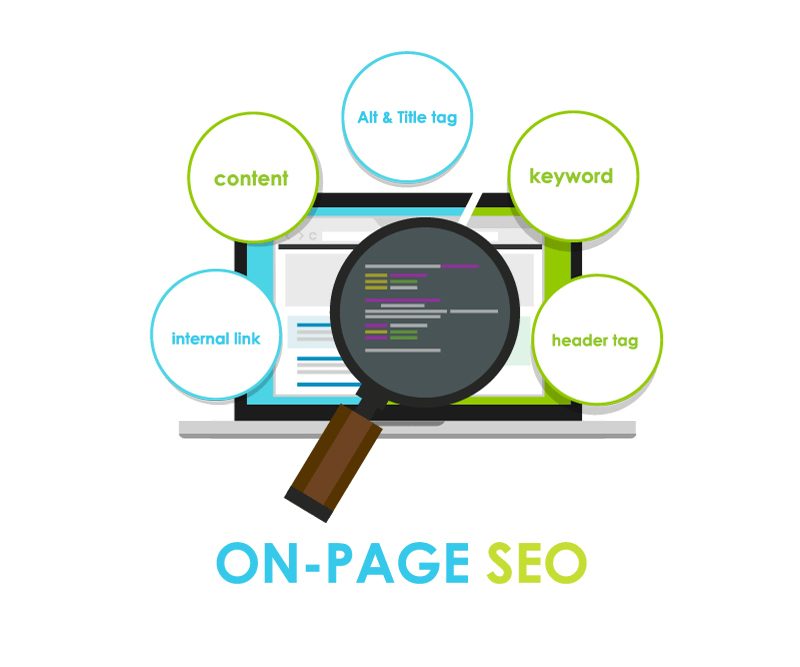
On-Page vs. Off-Page Medical SEO: What You Need To Know
On-page search engine optimization (SEO) boosts a healthcare website's visibility by refining content and technical elements within the site, aligning with search queries. Conversely, off-page SEO enhances the site's authority through external tactics such as link building, social media interaction, and reputation management, which are crucial for credibility.
This guide discusses on-page and off-page medical SEO. Let us highlight these topics:
- On-page SEO
- Off-page SEO
- Monitoring and measuring
- Integration
We have much to cover about medical website optimization, so let’s go!
Watch this video to learn more about the Digital Authority Partners approach to Medical SEO!
Understanding On-Page SEO

On-page SEO involves optimizing content quality, keyword usage, meta tags, headers, images, and URL structures to make web pages more relevant and accessible to search engine algorithms and users. It is pivotal in ensuring that web pages are technically optimized and offer valuable, authoritative, and user-friendly content.
On-page SEO leads to higher rankings and increased organic traffic for specific targeted keywords or topics. It focuses on fine-tuning elements within the website to align with search engine requirements and user intent. Here is an overview of these on-page SEO elements:
- Content quality. High-quality content is essential to on-page SEO. Content must be relevant, informative, and engaging, catering to user intent.
- Keyword optimization. Strategic use of keywords throughout the content is vital. This includes naturally using primary and secondary keywords within titles, headings, body text, and meta descriptions.
- Meta tags. Title tags and meta descriptions are essential for on-page SEO. These summarize the content and contain relevant keywords, enticing users to click through to the website from search results.
- Header tags (H1, H2, etc.). Proper use of header tags organizes content hierarchically and helps search engines understand the structure and importance of different sections within a page.
- URL structure. Creating SEO-friendly, descriptive, and concise URLs that contain targeted keywords can improve search engine rankings.
Optimizing these on-page elements contributes significantly to a website's visibility, relevance, and UX. These improve its overall search engine rankings and organic traffic. More on these later.
1. Optimizing Medical Content for On-Page SEO
Patients looking for symptom information or information about a medical procedure rely on website content such as articles, blogs, or video content. Thus, optimizing medical content for on-page SEO ensures patients have improved accessibility to relevant healthcare information.
On-page SEO allows medical content to be more discoverable to users seeking specific health-related information, thus enhancing the chances of appearing prominently in search engine results. This improves the website's ranking and ensures that authoritative and accurate medical content reaches a broader audience needing trustworthy healthcare information.
Consider the following content marketing strategies aligned with on-page SEO best practices:
- Conduct comprehensive keyword research to identify relevant and high-traffic keywords related to medical topics, treatments, conditions, or healthcare services. Use Google Keyword Planner to discover keywords that resonate with the target audience's search intent.
- Develop in-depth, informative content that addresses the specific needs and queries of the audience. Cover the topic comprehensively, providing accurate, trustworthy information and incorporating multimedia elements such as images, videos, or infographics.
- Structure healthcare content logically with clear headings, subheadings (using H1, H2, etc.), and bullet points to improve readability and facilitate scanning.
- Integrate primary and secondary keywords throughout the content, including titles, headings, body text, and meta tags.
- Aim for balanced keyword usage that maintains readability and context, avoiding keyword stuffing that can harm user experience and SEO rankings.
- Optimize for mobile devices, considering the increasing prevalence of mobile searches. Create a responsive design by optimizing load times, readability, and navigation, enhancing on-page SEO and user engagement.
Implementing these strategies will enhance the on-page SEO performance of medical content, ensure that it resonates with the audience, and maintain credibility as a reliable source of healthcare information.
2. Technical Aspects of On-Page SEO
The technical aspects of on-page SEO encompass optimizing various elements within a webpage to enhance search engine visibility. This includes optimizing HTML tags such as title tags, meta descriptions, and header tags with relevant keywords and structured data markup to provide clearer context to search engines.
Additionally, optimizing page loading speed, improving mobile friendliness, and making sure of a secure HTTPS protocol contribute to a robust technical foundation. This facilitates better crawling, indexing, and ranking of web pages in search engine results.
Here are five technical SEO elements and their influence on website performance and user experience on medical websites:
- Site speed. A fast-loading website is crucial for user experience. Slow-loading pages can lead to higher bounce rates, affecting rankings and dissatisfying users who expect quick access to medical information or services. For medical websites, a speedy site is essential to retaining visitor engagement.
- Mobile responsiveness. A mobile-responsive website is vital for SEO and user experience. Google prioritizes mobile-first indexing, so a mobile-friendly medical site ensures better rankings. For a good user experience in healthcare, responsive design is essential. Users want quick answers and information on the go.
- URL structure. Optimizing URL structures with descriptive, readable, and keyword-rich URLs aids search engines in understanding page content. Clean and logical URL structures enhance the user experience by providing clear navigation. For medical sites, clear URLs facilitate more accessible access to specific health information users seek.
- HTTPS and security. HTTPS encryption ensures data security and builds user trust, which is crucial for medical websites handling sensitive health information. A secure connection is essential to SEO performance and provides user confidence when accessing medical content or submitting personal information.
- Structured data markup. Implementing structured data markup, such as schema.org, helps search engines better understand the context of medical content. This leads to rich snippets or enhanced search results, improving click-through rates (CTR) and providing users with more informative results, positively impacting SEO and user experience.
These technical SEO elements optimize medical websites for better search visibility, higher rankings, and an improved user experience.
3. Understanding Off-Page SEO
Off-page SEO optimization efforts enhance website authority, credibility, and reputation. It primarily involves activities such as link building, social media engagement, online reviews, and influencer collaborations to establish the website's prominence and trustworthiness in the eyes of search engines and users.
Unlike on-page SEO, which focuses on optimizing content and technical elements within the website, off-page SEO revolves around building external signals and relationships. Off-page SEO boosts a site's reputation and relevance through factors beyond its direct control, emphasizing trustworthiness and authority in the wider online community.
These are the five off-page SEO elements critical for medical SEO:
- Link building from authoritative healthcare websites. Acquiring backlinks from reputable and authoritative medical websites or healthcare organizations can significantly boost a medical site's credibility and authority.
- Online reputation management and review generation. Positive reviews and high ratings build trust and credibility, influence potential patients' decisions, and improve the medical site's reputation.
- Social media engagement and healthcare communities. Sharing valuable medical content, participating in health-related forums, and engaging with patients or peers can amplify the medical site's visibility and establish authority within healthcare communities.
- Healthcare content promotion through influencers. Influencers with a credible following in the medical field can endorse your content, improving its visibility and credibility among its audience.
- Local SEO strategies. Local citations and mentions contribute to the medical site's relevance and visibility in local search results.
Implementing these off-page SEO strategies tailored for medical websites can enhance credibility, authority, and visibility, positioning the site as a trusted resource within the healthcare domain.
4. Building Backlinks for Medical Websites
Backlinks signal credibility and authority to search engines. In the medical field, where trust and expertise are critical, quality backlinks from authoritative healthcare websites or reputable sources serve as endorsements, validating the reliability and trustworthiness of a medical website's content.
Acquiring high-quality backlinks elevates a medical practice's visibility in search engine rankings. It enhances its reputation as a trusted source of healthcare information, which is critical for attracting patients seeking reliable medical advice or services. These techniques can help marketers acquire high-quality backlinks for their medical SEO:
- Offer to write informative and valuable guest posts for authoritative healthcare websites or medical blogs.
- Partner with healthcare professionals, specialists, or institutions for collaborative content creation or research.
- Speak at medical conferences, seminars, or webinars and request that event organizers link to the medical website for additional resources or follow-up information.
- Develop visually engaging and informative infographics or visual content related to medical topics.
- Encourage satisfied patients, healthcare advocacy groups, or patient support organizations to share their positive experiences or endorse medical services online.
Employing these techniques while ensuring content relevance and quality can facilitate the acquisition of high-quality backlinks from reputable sources within the healthcare industry.
5. Using Social Media in Off-Page SEO
Social media engagement fosters brand visibility by increasing website traffic and enhancing online presence. Active participation in social media platforms enables medical practices to share valuable healthcare content, engage with patients, and amplify their reach within relevant communities.
Additionally, social media interactions, shares, and mentions can generate backlinks, indirectly influencing search engine rankings and bolstering a medical website's overall authority and credibility. Leverage social platforms to increase visibility and create link opportunities.
- Share informative and valuable healthcare content on social media platforms. Content could include blog posts, articles, infographics, videos, or studies related to medical topics, encouraging shares, likes, and engagement.
- Participate actively in healthcare-related groups, forums, or communities on LinkedIn, Facebook, or Reddit platforms.
- Collaborate with influential healthcare professionals, medical organizations, or influencers on social media.
- Monitor conversations, hashtags, and mentions related to medical topics using social media listening tools.
- Engage with users discussing relevant healthcare issues, offer expertise, and share resources, which can lead to organic link opportunities.
- Host live webinars, question-answer sessions, or AMA (Ask Me Anything) sessions on social media platforms focusing on healthcare topics.
Implementing these strategies on social media platforms enhances visibility, creates opportunities for acquiring backlinks, and amplifies the reach of medical content, strengthening the overall off-page SEO efforts.
Monitoring and Measuring SEO Performance

Monitoring and measuring SEO tracks rankings, organic traffic, and user engagement metrics, allowing for informed decision-making and strategy adjustments. For medical websites, where accuracy and trustworthiness are critical, regular monitoring ensures the delivery of reliable healthcare information, maintaining competitiveness in search results.
Here are techniques to track the effectiveness of both on-page and off-page SEO strategies for a medical website:
- Utilize Google Analytics to monitor website traffic, user behavior, and engagement metrics such as page views, bounce rates, and session duration. Google Search Console provides insights into keyword performance, impressions, and CTR for both on-page and off-page SEO efforts.
- Employ rank-tracking tools to monitor keyword rankings and fluctuations over time. These tools help track the positions of targeted keywords, allowing assessment of the influence of on-page and off-page optimization strategies.
- Conduct regular backlink analysis to track new backlinks, referring domains, and the quality of acquired links.
- Evaluate content performance metrics, including page views, social shares, comments, or backlinks earned, to gauge the effectiveness of on-page SEO strategies.
- Set up conversion tracking in Google Analytics to monitor specific goals, such as appointment bookings, newsletter sign-ups, or downloads.
These methods allow comprehensive tracking and assessment of the effectiveness of both on-page and off-page SEO strategies. These enable data-driven decision-making and iterative improvements to enhance a medical website's visibility, authority, and performance.
Integrating On-Page and Off-Page SEO
Integrating on-page and off-page SEO is vital for achieving comprehensive online visibility in the medical industry. While on-page SEO optimizes content and technical elements within the website, off-page SEO focuses on building authority and credibility through external signals, such as backlinks and social validation.
A balanced approach harmonizes these strategies, enhancing content relevance while establishing the website's credibility and trustworthiness. Integration maximizes visibility and attracts a broader audience seeking reliable healthcare information and services.
Create a cohesive SEO plan that integrates both on-page and off-page elements using these strategies:
- Develop a holistic keyword strategy that aligns on-page optimization with off-page content promotion. To ensure consistency and relevance, incorporate targeted keywords in on-page elements while using them as anchor texts for off-page link building.
- Create high-quality, informative medical content optimized for on-page SEO. Simultaneously, promote this content through off-page strategies, including guest posting, influencer collaborations, or social media sharing.
- Implement on-page technical SEO elements such as site speed optimization, mobile responsiveness, and structured data markup. Pair this with off-page link-building efforts, acquiring high-quality backlinks from authoritative healthcare websites.
- Merge on-page local optimization, such as location-specific keywords and NAP consistency, with off-page local strategies, in particular local citations, community engagement, and participation in local healthcare events.
Regularly monitor performance metrics from both on-page and off-page efforts using analytics tools. Analyze data to identify areas for improvement, refine strategies, and iterate the SEO plan to maintain a cohesive and evolving approach aligned with current trends and user behavior.
By using these strategies together, a medical website can make a strong SEO plan that coordinates both on-page and off-page elements. This will help the website be more visible, trustworthy, and relevant in healthcare-related searches.
Summing Up
In healthcare marketing, on-page SEO focuses on optimizing individual web pages within a website, enhancing content relevance and technical aspects to align with search engine requirements. It improves the user experience, provides valuable healthcare information, and optimizes content quality, keywords, and meta tags.
In contrast, off-page SEO emphasizes building website authority and credibility through external signals such as backlinks, social validation, and reputation management, establishing trustworthiness and prominence within the broader online healthcare community, visibility, and credibility.
How can integrating on-page and off-page SEO tactics boost your overall online presence? Ask an expert today. Contact Digital Authority Partners (DAP) today.
Want To Meet Our Expert Team?
Book a meeting directly here




